Timing Device Market Research, 2032
The global timing device market size was valued at $5.7 billion in 2022, and is projected to reach $12.2 billion by 2032, growing at a CAGR of 8.3% from 2023 to 2032.
Timing devices play a crucial role in guaranteeing accuracy and effectiveness in a wide range of applications, making them indispensable to several sectors. The core of timing devices is crystal oscillators, which supply steady oscillations that are essential for microcontrollers, clocks, and communication instruments. These oscillators must be extremely accurate, particularly in fields where precision is a must. Real-Time Clocks (RTCs) are essential timing devices in the world of microcontrollers. RTCs, which are included in many electronic devices, provide precise time and date monitoring, which makes processes run more smoothly. This kind of capability is critical in industries where synchronization and chronological precision are necessary for maximum operation, such as smart appliances, medical devices, and automotive systems.
Precise time is essential to contemporary corporate processes, particularly in the field of telecommunications. A standard used in communication networks; Precision Time Protocol (PTP) uses high-precision oscillators to synchronize network devices. This synchronization emphasizes how important timing devices are to preserving the integrity of international communication networks as timing accuracy in microseconds is crucial for financial transactions. Timing devices play a key role in industrial automation by helping to optimize production processes. Timer and counter are basic timing devices used by programmable logic controllers (PLCs), which are the basis of industrial control systems, to manage the length and frequency of activities.
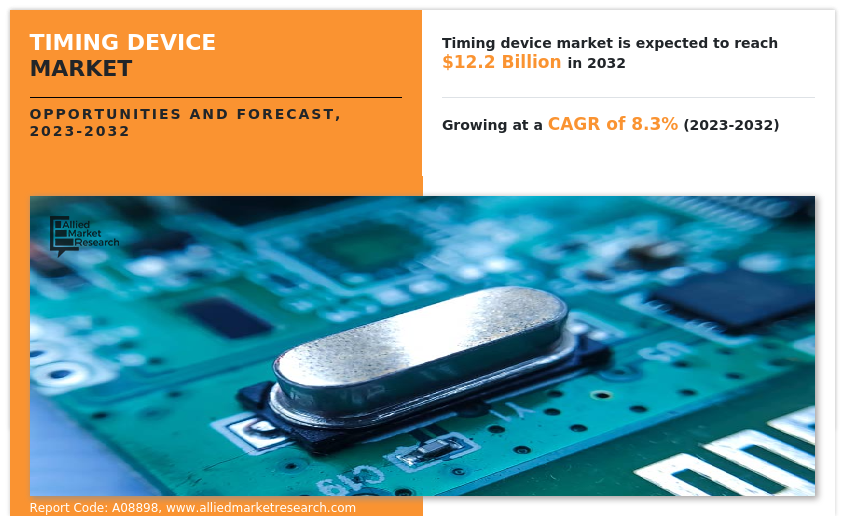
The timing device market is segmented into Product Type, Material and Industry Vertical.
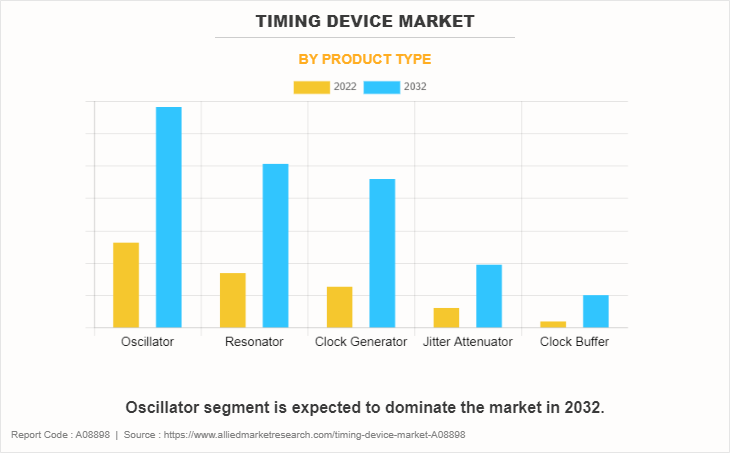
On the basis of product type, it is classified into oscillator, resonator, clock generator, jitter attenuator, and clock buffer. The oscillator segment is further bifurcated into MEMS oscillator and crystal oscillator.
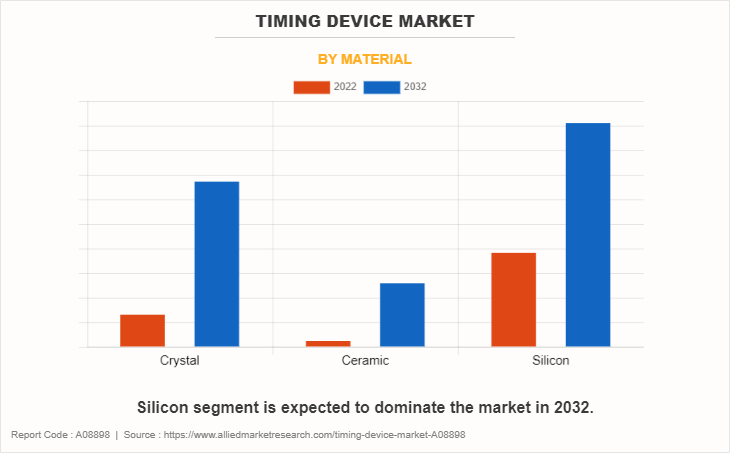
On the basis of material, it is segmented into crystal, ceramic, and silicon.
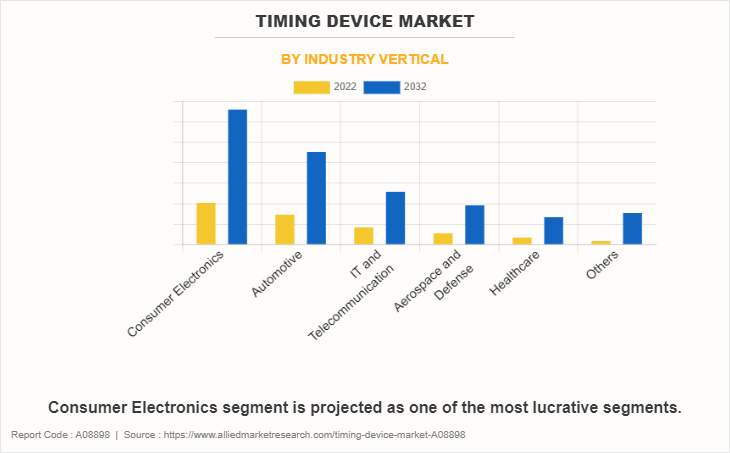
On the basis of industry vertical, it is divided into consumer electronics, automotive, IT and telecommunication, aerospace and defense, healthcare, and others.
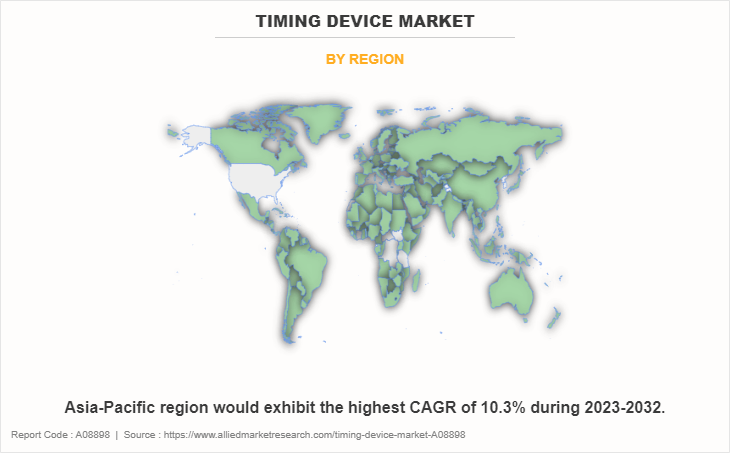
Region wise, the timing device market trends are analyzed across North America (U.S. and Canada), Europe (UK, Germany, France, Italy, Spain, and rest of Europe), Asia-Pacific (China, Japan, India, South Korea, Australia and rest of Asia-Pacific), and LAMEA (Latin America, the Middle East, and Africa).
These gadgets provide effective coordination when managing conveyor belt operations and keeping track of manufacturing amounts. Precise timing devices are essential in the aviation industry owing to its strict safety regulations. These gadgets synchronize vital avionics tasks including communication, navigation, and flight control. This dependency is demonstrated by the usage of Global Positioning System (GPS) receivers, where precise timing is essential for triangulating the position of the aircraft and guaranteeing safe operations. Precise timing devices are highly valued by scientific research, which is the foundation of innovation. Precise scheduling is essential for accurate data collection in experiments, which span from the study of biological processes to chemical reactions.
Atomic clocks are used as benchmarks in science and technology and demonstrate the amazing progress in timing technology. Sophisticated timing devices are essential to the smooth operation of wearable technology in the booming field of consumer electronics. Smartwatches, fitness trackers, and health monitoring gadgets measure and track a variety of health variables with the use of accurate timing. The incorporation of various timing devices into small devices highlights the degree of miniaturization and flexibility attained in modern timing technology.
The demands for timing devices change with the advancement of technology, especially in the rapidly developing Internet of Things (IoT) sector. Timing devices are used in IoT contexts ranging from smart homes to industrial settings, ensuring exact synchronization for smooth communication in networked equipment. As technology advances further, timing devices are expected to become increasingly important, influencing innovation and usefulness in a variety of industries within the global enterprise.
The timing device industry faced significant challenges as well as opportunities and interruptions due to the Covid-19 pandemic. The first epidemic caused problems in the supply chain, which had an impact on timing device manufacture and distribution around the world. But as digital transformation quickened and companies adjusted to remote work, there was a greater need for precise timing solutions in areas such as banking, healthcare, and telecommunications.
The market recovered because of its reliance on synchronized communication networks and because different applications required precise time. The need for sophisticated timing devices was further boosted by the move to 5G technology and the growth in use of Internet of Things (IoT) devices. Despite the early hurdles, the market for timing devices proved resilient and adaptable in overcoming the obstacles presented by the pandemic, eventually putting itself in a position to develop in the post-COVID period.
Competitive Analysis
The key players profiled in the report include Seiko Epson Corp., IQD Frequency Products Ltd., Texas instruments Inc., Infineon Technologies AG, TXC Corp., Microchip Technology Inc., Rakon Ltd., Kyocera Corporation, Murata manufacturing Co., Ltd., and Microsemi Corporation. Market players have adopted various strategies such as product launch, collaboration, partnership, agreement, expansion, and acquisition to expand their foothold in the timing device industry.
Top Impacting Factors
The timing device market is expected to witness notable growth owing to rise in adoption of timing ICs in consumer electronics sector and growth in need for microwave components in the defense sector. Moreover, rise in adoption of silicon-based oscillator on mems technology and advancements in semiconductor process technology and circuit integration over conventional quartz oscillators is expected to provide lucrative opportunity for the timing device market growth during the forecast period. On the contrary, high development cost of timing devices and increase in complexity owing to growth in miniaturization of semiconductor clock ICs limits the growth of the timing device market.
Historical Data & Information
The global Timing device market outlook is highly competitive, owing to the strong presence of existing vendors. Vendors in the Timing device market with extensive technical and financial resources are expected to gain a competitive advantage over their competitors because they can cater to timing device market demand. The competitive environment in this market is expected to worsen as technological innovations, product extensions, and different strategies adopted by key vendors increase.
Key Developments/ Strategies
Seiko Epson Corp., IQD Frequency Products Ltd., Texas instruments Inc., Infineon Technologies AG, TXC Corp., Microchip Technology Inc., Rakon Ltd., Kyocera Corporation, Murata manufacturing Co., Ltd., and Microsemi Corporation are the top companies holding a prime Timing device market share. Top market players have adopted various strategies, such as product development, acquisition, innovation, partnership, and others to expand their foothold in the Timing device market.
- In July 2023, the first oven-controlled crystal oscillator (OCXO) products from KYOCERA AVX have been made available. The new voltage-controlled oscillators from KYOCERA AVX, the KOV Series standard voltage-controlled oscillators and the KLN Series low-noise voltage-controlled oscillators, use robust designs and modern layout topologies to deliver excellent performance in these and other applications. These products also enable customers to achieve extremely stable timing sources in the form of CMOS clock outputs or extremely stable frequencies in the form of sinewaves.
- In May 2023, with a Series A investment of about US$11 million (CA$15 million), Stathera Inc. is offering MEMS timing systems. Together with additional involvement from key partners MediaTek, Seiko Epson, and TXC, BDC Capital and Celesta Capital spearheaded the investment in Stathera.
- In November 2022, the RPT7050LG, a low g-sensitivity TCXO with outstanding stability and a 7.0 x 5.0 x 1.5 mm package size has been launched by Rakon. It is presently the most sophisticated small low g-sensitivity TCXO available, with a guaranteed sensitivity of 0.1 ppb/g.
- In October 2022, Microchip Technology Inc. acquired Tekron International Limited, the world leader in high-precision GPS and atomic clock time-keeping technology and solutions for the smart grid and other industrial applications. The specifics of the agreement are private.
- In May 2021, the CSTNE-VH5T series of ceramic resonators (CERALOCK) with enhanced frequency accuracy and support for CAN-FD has been released, according to Murata Manufacturing Co., Ltd.
- In April 2020, the closing of the acquisition of Cypress Semiconductor Corporation was announced by Infineon Technologies AG. With the closing, the San Jose-based business officially joined Infineon.
Key Benefits For Stakeholders
- This report provides a quantitative analysis of the market segments, current trends, estimations, and dynamics of the timing device market analysis from 2022 to 2032 to identify the prevailing timing device market opportunities.
- The market research is offered along with information related to key drivers, restraints, and opportunities.
- Porter's five forces analysis highlights the potency of buyers and suppliers to enable stakeholders make profit-oriented business decisions and strengthen their supplier-buyer network.
- In-depth analysis of the timing device market segmentation assists to determine the prevailing timing device market opportunity.
- Major countries in each region are mapped according to their revenue contribution to the global timing device market demand.
- Market player positioning facilitates benchmarking and provides a clear understanding of the present position of the market players.
- The timing device market forecast report includes the analysis of the regional as well as global timing device market trends, key players, market segments, application areas, and market growth strategies.
Timing Device Market Report Highlights
| Aspects | Details |
| Market Size By 2032 | USD 12.2 billion |
| Growth Rate | CAGR of 8.3% |
| Forecast period | 2022 - 2032 |
| Report Pages | 311 |
| By Product Type |
|
| By Material |
|
| By Industry Vertical |
|
| By Region |
|
| Key Market Players | Kyocera Corporation., Rakon Ltd, Microchip Technology Inc., Infineon Technologies AG, IQD Frequency Products Ltd., Texas Instruments Inc., Microsemi Corporation., SEIKO EPSON CORP, TXC Corp., Murata Manufacturing Co., Ltd. |
Analyst Review
The timing device market is highly competitive, owing to the strong presence of existing vendors. The concerned vendors, who have access to extensive technical and financial resources, are anticipated to gain a competitive edge over their rivals, as they have the capacity to cater to the global market requirements. The competitive environment in the market is expected to further intensify with increase in technological innovations, product extensions, and different strategies adopted by key vendors.?
This optimistic prognosis was powered by the rise in demand for timing devices in defense applications. In addition, the market optimism was aided by newly developed applications in the automotive sector. Market interest in current technical developments in the concerned market was high. To enhance the performance, flexibility, and durability of the technology, producers and researchers were always looking into new innovations. This ongoing innovation was viewed as an indication of potential future growth.??
The market growth is supplemented by proactive surge in timing solutions, owing to technological advancements. These factors have allowed emerging markets to evolve as largest markets during the forecast period, both from the demand as well as the supply side. Public & private organizations have substantially invested in R&D activities and fabrication techniques to develop cost-effective timing devices. Asia-Pacific is the major revenue contributor to the global market, followed by North America. The market growth in Asia-Pacific is expected to significantly increase during the forecast period. The key players profiled in the report include Seiko Epson Corp., IQD Frequency Products Ltd., Texas instruments Inc., Infineon Technologies AG, TXC Corp., Microchip Technology Inc., Rakon Ltd., Kyocera Corporation, Murata manufacturing Co., Ltd., and Microsemi Corporation. Market players have adopted various strategies such as product launch, collaboration, partnership, agreement, expansion, and acquisition, to expand their foothold in the timing device industry.
The timing device market was valued at $5,662.65 million in 2022 and is estimated to reach $12,200.10 million by 2032, exhibiting a CAGR of 8.3% from 2023 to 2032.
Seiko Epson Corp., IQD Frequency Products Ltd., Texas instruments Inc., Infineon Technologies AG, TXC Corp., Microchip Technology Inc., Rakon Ltd., Kyocera Corporation, Murata manufacturing Co., Ltd., and Microsemi Corporation are the top companies holding a prime share in the Timing device market.
Asia-Pacific contributed maximum revenue in 2022 and is expected to grow at a faster rate as compared to other regions.
The timing device market is expected to witness notable growth owing to rise in adoption of timing ICs in consumer electronics sector and growth in need for microwave components in the defense sector. Moreover, rise in adoption of silicon-based oscillator on mems technology and advancements in semiconductor process technology and circuit integration over conventional quartz oscillators is expected to provide lucrative opportunity for the growth of the market during the forecast period. On the contrary, high development cost of timing devices and increase in complexity owing to growth in miniaturization of semiconductor clock ICs limits the growth of the timing device market.
On the basis of industry vertical, the consumer electronics segment was the largest contributor of revenue in 2022 and is expected to grow at a CAGR of 9.9% from 2023 to 2032.
Loading Table Of Content...
Loading Research Methodology...



